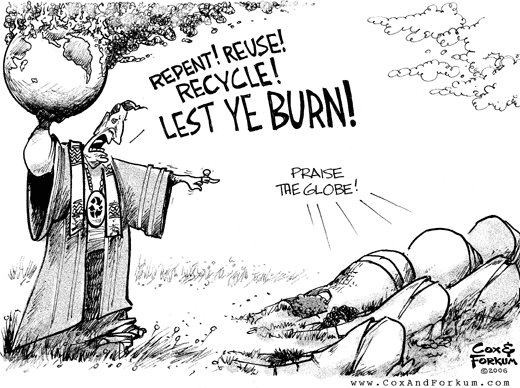Al Gore’s “An Inconvenient Truth” opened around the country earlier this year. In the film Gore pulls together evidence from every corner of the globe to convince us that climate change is happening fast, we are to blame, and if we don’t act immediately, our Earth will be all but ruined. However, as you sit through the film, consider the following inconvenient truths:
(1) Near the beginning of the film, Gore pays respects to his Harvard mentor and inspiration, Dr. Roger Revelle. Gore praises Revelle for his discovery that atmospheric CO2 levels were rising and could potentially contribute to higher temperatures at a global scale. There is no mention of Revelle’s article published in the early 1990s concluding that the science is “too uncertain to justify drastic action.” (S.F. Singer, C. Starr, and R. Revelle, “What to do about Greenhouse Warming: Look Before You Leap. Cosmos 1 (1993) 28-33.)
(2) Gore discusses glacial and snowpack retreats atop Mt. Kilimanjaro, implying that human induced global warming is to blame. But Gore fails to mention that the snows of Kilimanjaro have been retreating for more than 100 years, largely due to declining atmospheric moisture, not global warming. Gore does not acknowledge the two major articles on the subject published in 2004 in the International Journal of Climatology and the Journal of Geophysical Research showing that modern glacier retreat on Kilimanjaro was initiated by a reduction in precipitation at the end of the nineteenth century and not by local or global warming.
(3) Many of Gore’s conclusions are based on the “Hockey Stick” that shows near constant global temperatures for 1,000 years with a sharp increase in temperature from 1900 onward. The record Gore chooses in the film completely wipes out the Medieval Warm Period of 1,000 years ago and Little Ice Age that started 500 years ago and ended just over 100 years ago. There is evidence from throughout the world that these climate episodes existed, but on Gore’s Hockey Stick, they become nothing more than insignificant fluctuations (Gore even jokes at one point about the Medieval Warm period).
(4) You will certainly not be surprised to see Katrina, other hurricanes, tornadoes, flash floods, and many types of severe weather events linked by Gore to global warming. However, if one took the time to read the downloadable “Summary for Policymakers” in the latest report from the United Nations Intergovernmental Panel on Climate Change (IPCC), one would learn that “No systematic changes in the frequency of tornadoes, thunder days, or hail events are evident in the limited areas analysed” and that “Changes globally in tropical and extra-tropical storm intensity and frequency are dominated by inter-decadal and multi-decadal variations, with no significant trends evident over the 20th century.”
(5) Gore claims that sea level rise could drown the Pacific islands, Florida, major cities the world over, and the 9/11 Memorial in New York City. No mention is made of the fact that sea level has been rising at a rate of 1.8 mm per year for the past 8,000 years; the IPCC notes that “No significant acceleration in the rate of sea level rise during the 20th century has been detected.”

(6) Near the end of the film, we learn of ways the United States could reduce emissions of greenhouse gases back to the levels of 1970. OK. Assume the United States accomplishes this lofty goal, would we see any impact on climate? The well-known answer is no. China, India and many other countries are significantly increasing their emission levels, and global concentrations of CO2 may double this century no matter what we decide to do in the United States. Even if the Kyoto Protocol could be fully implemented to honor the opening of this movie, the globe would be spared no more than a few hundredths of a degree of warming.
Throughout the film Gore displays his passion for the global warming issue, and it is obvious that he has dedicated a substantial amount of time to learning about climate change and the greenhouse effect. This leads to an obvious question. The Kyoto Protocol was negotiated in December of 1997 giving the Clinton-Gore administration more than three years to present the Protocol to the United States Senate for ratification. Given Gore’s position in the senate and his knowledge and passion for global warming, one must wonder why then Vice President Gore did not seize on what appears to have been an opportunity of a lifetime?

“An Inconvenient Truth” is billed as the scariest movie you’ll ever see. It may well be, but that’s in part because it is not the most accurate depiction of the state of global warming science. The enormous uncertainties surrounding the global warming issue are conveniently missing in “An Inconvenient Truth.”
First appeared in TCS Daily (www.tcsdaily.com) — republished here by permission. Cartoons by Cox and Forkum.




